Abstract
The vast majority of the mouse and human genomes consist of repetitive elements (REs), while protein-coding sequences occupy only ∼3 %. It has been reported that the Y chromosomes of both species are highly populated with REs although at present, their complete sequences are not available in any public database. The recent update of the mouse genome database (Build 38.1) from the National Center for Biotechnology Information (NCBI) indicates that mouse chromosome Y is ∼92 Mb in size, which is substantially larger than the ∼16 Mb reported previously (Build 37.2). In this study, we examined how REs are arranged in mouse chromosome Y (Build 38.1) using REMiner-II, a RE mining program. A combination of diverse REs and RE arrays formed large clusters (up to ∼28 Mb in size) and most of them were directly or inversely related. Interestingly, the RE population of human chromosome Y (NCBI Build 37.2-current) was less dense, and the RE/RE array clusters were not evident in comparison to mouse chromosome Y. The annotated gene loci were distributed in five different regions and most of them were surrounded by unique RE arrays. In particular, tandem RE arrays were embedded into the introns of two adjacent gene loci. The findings from this study indicate that the large and interrelated clusters of REs and RE arrays predominantly represent the unique organizational pattern of mouse chromosome Y. The potential interactions among the clusters, which are populated with various interrelated REs and RE arrays, may play a role in the structural configuration and function of mouse chromosome Y.






Similar content being viewed by others
Abbreviations
- HSAY:
-
Homo sapiens chromosome Y
- MMU18:
-
Mus musculus chromosome 18
- MMUX:
-
Mus musculus chromosome X
- MMUY:
-
Mus musculus chromosome Y
- NCBI:
-
National Center for Biotechnology Information
- Rbmy1a1:
-
RNA binding motif protein Y chromosome, family 1, member A1
- RE:
-
Repetitive element
References
Akeson EC and Davisson MT (2001) Mitotic chromosome preparations from mouse cells for karyotyping. Curr Protoc Hum Genet Chapter 4: Unit4 10.
Bishop CE, Mitchell MJ (1999) Mouse Y chromosome. Mamm Genome 10(10):962
Collins FS, Lander ES, Rogers J et al (2004) Finishing the euchromatic sequence of the human genome. Nature 431(7011):931–945
Cooke HJ, Schmidtke J, Gosden JR (1982) Characterisation of a human Y chromosome repeated sequence and related sequences in higher primates. Chromosoma 87(5):491–502
Fraser CM, Eisen JA, Salzberg SL (2000) Microbial genome sequencing. Nature 406(6797):799–803
Gilissen C, Hoischen A, Brunner HG, Veltmen JA (2012) Disease gene identification strategies for exome sequencing. Eur J Hum Genet 20(5):490–497
Gonzaga-Jauregui C, Lupski JR, Gibbs RA (2012) Human genome sequencing in health and disease. Annu Rev Med 63:35–61
Gregory SG, Sekhon M, Schein J et al (2002) A physical map of the mouse genome. Nature 418(6899):743–750
Guda K, Upender MB, Belinsky G et al (2004) Carcinogen-induced colon tumors in mice are chromosomally stable and are characterized by low-level microsatellite instability. Oncogene 23(21):3813–3821
Jobling MA, Tyler-Smith C (2003) The human Y chromosome: an evolutionary marker comes of age. Nat Rev Genet 4(8):598–612
Kaiser J (2008) DNA sequencing. A plan to capture human diversity in 1000 genomes. Science 319(5862):395
Kim WC, Lee KH, Shin KS et al (2012) REMiner-II: a tool for rapid identification and configuration of repetitive element arrays from large mammalian chromosomes as a single query. Genomics 100(3):131–140
Lee C, Morton CC (2008) Structural genomic variation and personalized medicine. N Engl J Med 358(7):740–741
Lee KH, Lee YK, Kwon DN et al (2011) Identification of a unique library of complex, but ordered, arrays of repetitive elements in the human genome and implication of their potential involvement in pathobiology. Exp Mol Pathol 90(3):300–311
Lee YK, Lee KH, Iim SG et al (2012) Unique profile of ordered arrangements of repetitive elements in the C57BL/6J mouse genome implicating their functional roles. PLoS One 7(4):e35156
Skaletsky H, Kuroda-Kawaguchi T, Minx PJ et al (2003) The male-specific region of the human Y chromosome is a mosaic of discrete sequence classes. Nature 423(6942):825–837
Skrisovska L, Bourgeois CF, Stefl R et al (2007) The testis-specific human protein RBMY recognizes RNA through a novel mode of interaction. EMBO Rep 8(4):372–379
Waterston RH, Lindblad-Toh K, Birney E et al (2002) Initial sequencing and comparative analysis of the mouse genome. Nature 420(6915):520–562
Wheeler DA, Srinivasan M, Egholm M et al (2008) The complete genome of an individual by massively parallel DNA sequencing. Nature 452(7189):872–876
Acknowledgments
This study was supported, in part, by grants from Shriners of North America (no. 86800 to KC and no. 84302 to KHL [postdoctoral fellowship]) and the National Institutes of Health (R01 GM071360 to KC).
Author information
Authors and Affiliations
Corresponding author
Additional information
Responsible Editor: Conly Rieder.
Rights and permissions
About this article
Cite this article
Lee, KH., Kim, WC., Shin, KS. et al. Large interrelated clusters of repetitive elements (REs) and RE arrays predominantly represent reference mouse chromosome Y. Chromosome Res 21, 15–26 (2013). https://doi.org/10.1007/s10577-012-9334-8
Received:
Revised:
Accepted:
Published:
Issue Date:
DOI: https://doi.org/10.1007/s10577-012-9334-8




